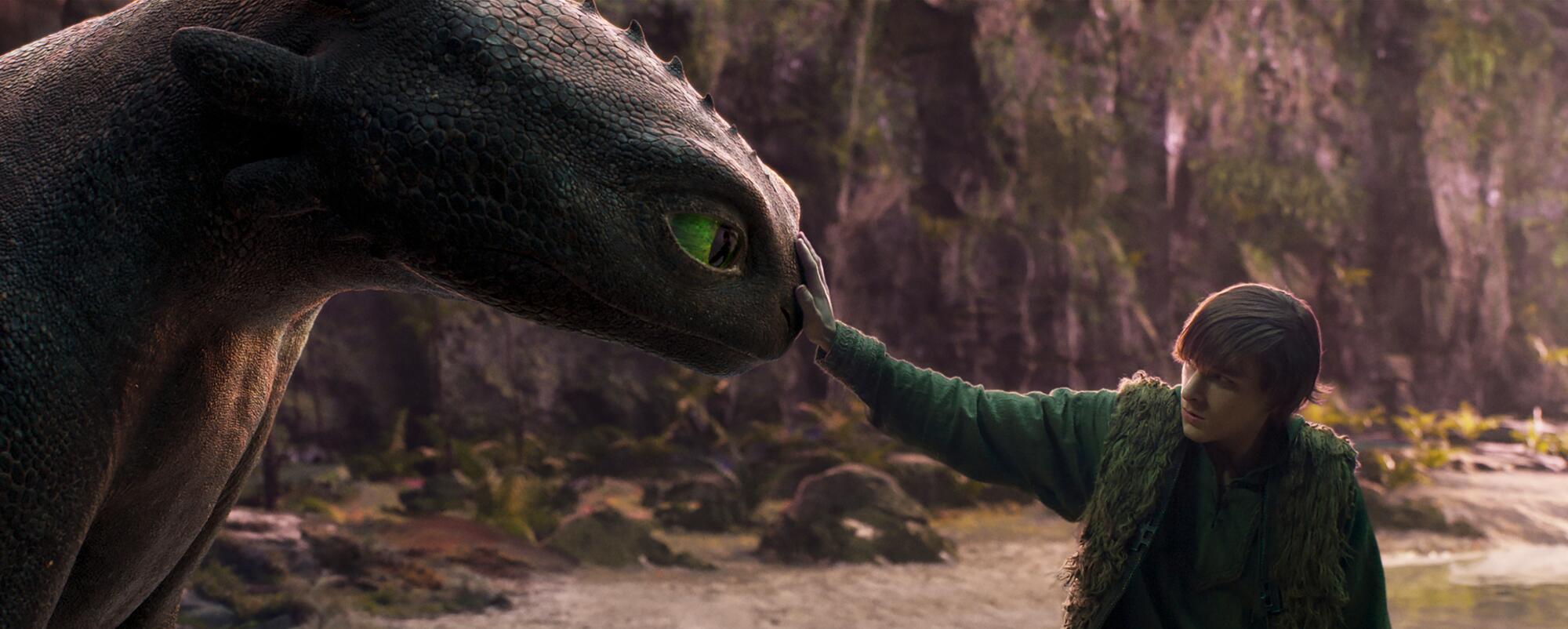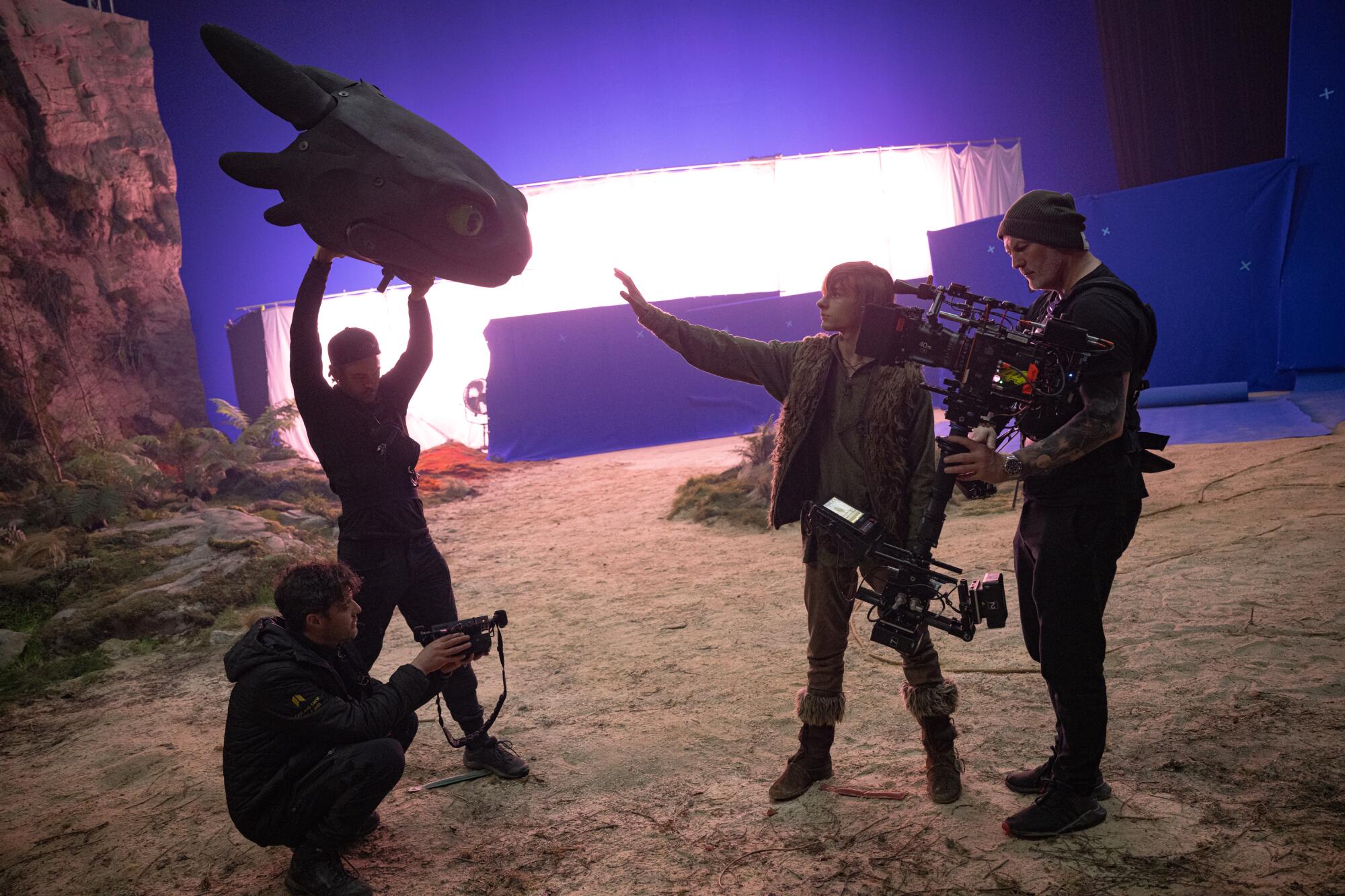
- Share via
Whether soaring through the sky or sharing a playful moment with his human bestie Hiccup, Toothless, the dark-hued dragon with a friendly face and an injured tail, disarms you with his endearing nature.
It’s no surprise that he’s become the emblem of the “How to Train Your Dragon” animated movies, the first of which arrived in 2010. (There have since been two sequels, three separate TV series and five shorts.) A fan favorite among Gen-Z viewers, Toothless now returns to the big screen in a new hyper-realist iteration for the live-action remake, now in theaters.
And in an unprecedented move, Dean DeBlois, who directed all three “Dragon” animated films — as well as 2002’s original “Lilo & Stitch,” along with Chris Sanders — was asked to helm the live-action reimagining. It was his priority to preserve Toothless’ essence.
“He is our most recognizable dragon within the entire assortment,” DeBlois says on the phone. “And he has a lot of sentience and personality that comes through. And so much of it is expressed in this face that’s quite Stitch-like with the big eyes, the ear plates and the broad mouth.”
In fact, the entire live-action endeavor hinged on whether Toothless could be properly translated as a photorealistic dragon among human actors and physical sets, while retaining the charm of the animated movies.

According to Christian Manz, the new film’s visual effects supervisor, when Peter Cramer, president of Universal Pictures, initially considered the project back in 2022, he wasn’t convinced Toothless would work. His touchstone for a fantastical creature that successfully achieved believability was the Hippogriff, a winged four-legged creature seen in 2004’s “Harry Potter and the Prisoner of Azkaban.”
To test the viability of a new Toothless, DreamWorks enlisted British visual effects and computer animation outfit Framestore to spend three months trying to create a “realistic” version of Toothless. Framestore has had some popular successes to its name: Paddington Bear in the film series, Dobby from the “Harry Potter” universe and Groot and Rocket Raccoon from the Marvel movies.
“We always knew that we weren’t aiming for a real dragon, as in a ‘Game of Thrones’ dragon,” says Manz, via video call from the U.K.
Toothless’ design, particularly his facial features, presented a challenge for Manz and the team at Framestore. If they made his eyes or his mouth too small or if they tried to drastically reshape his head with more naturalism in mind, he quickly lost his personality.
“His big, expressive face with eyes that are larger than any animal in the animal kingdom, including the blue whale, had to remain because, without them, we felt like we were going to be delivering a lesser version of Toothless,” says DeBlois.
The season looks strong, loaded with the kind of big Hollywood swings, smart indie alternatives and a fair amount of delicious-looking dumb, necessary in every summer diet.
A stage show based on the first film called “How to Train Your Dragon: Live Spectacular,” which toured Australia and New Zealand in 2012, radically changed the design — to a mixed response. “Toothless was too creature-like and it just wasn’t as appealing and as charming,” says Simon Otto, head of character animation for all three animated movies, via Zoom.
While they may be too subtle for an untrained viewer to notice, certain design changes have been made that differentiate the live-action Toothless from his animated counterpart.
“He’s now bigger, his head’s smaller, his eyes are actually smaller,” says Manz. The nuanced reshaping of his head and his body was intentional: an effort to make him blend into a photorealistic world.
“The interesting thing is that when people see the live-action movie, they say, ‘Oh, it’s Toothless, like he stepped out of the animated movie,’” says DeBlois. “But in truth, if you put them side by side, you’ll see quite a few differences.”
The texture of Toothless’ body needed to be more intricate for the live-action version, so he would feel more convincingly integrated within the environments.
“In the animation, he’s quite smooth,” says Manz. “We tried very snake-like skin, but it just made him look very unfriendly. You wouldn’t want to put your hand on his forehead.”

Both on-screen versions of Toothless were crafted using essentially the same digital technique: computer animation. The difference here is that the one meant to share space with a flesh-and-blood world, with distinct aesthetic concerns. Even if seeking realism in creatures that only exist in our imagination might seem counterintuitive, the goal is to make them feel palpable within their made-up realm.
“One of the things I don’t like about live-action remakes is they seem to try to want to replace the animated source, and I find myself very protective of it,” says DeBlois with refreshing candor. “We tried to create a version that lives alongside it. It follows the beats of that original story, but brings new depths and expanded mythology and more immersive action moments and flying. But it’s never trying to replace the animated movie because I’m very proud of that film.”
Toothless as we now know him originated expressly for the screen. The Toothless in Cressida Cowell’s originating book series is tiny and green (a design that can be seen in the first animated movie in the form of a minuscule dragon known as Terrible Terror).
But when DeBlois and Sanders came aboard, 15 months before the 2010 release, replacing the previous directors, their first major change was to make Toothless a dragon that could be ridden.
It was the screensaver of a black panther that first inspired the look of Toothless in the animated films. Otto, one of the designers who knows Toothless best (he drew the original back in 2008), recalls his real-world animal references.
“He is a mix between a bird of prey, like a peregrine falcon, with extremely streamlined shapes — of course a feline but also a Mexican salamander called an axolotl,” Otto says. Sanders’ design for Disney superstar Stitch, namely his large almond-shaped eyes, ears and pronounced mouth, also influenced the design.
“There’s a little bit of a design influence from Stitch in Toothless’ face that makes them feel like they’re distant cousins,” says DeBlois.
He believes that making Toothless more closely resemble a mammal, rather than a reptile, and giving him pet-like qualities were the keys for him becoming so memorable.
“[We] spent a lot of time on YouTube looking at videos of dogs and cats doing funny things,” he says. “And we would try to incorporate a lot of that behavior into Toothless with the hopes that when people watched the movie, they would say, ‘That’s just like my cat’ or ‘My dog does that.’ We wanted him to feel like a big pet. Ferocious and dangerous at first, but then a big cuddly cat after.”

On the set of the live-action movie, Toothless and the other dragons existed as large puppets with simple functions, operated by a team of master puppeteers led by Tom Wilton, a performer who had worked on the “War Horse” stage play.
Using puppets was meant to provide the actors, especially Mason Thames, who plays Hiccup, a real-world scene partner. The Toothless foam puppet had an articulated jaw and articulated ear plates that allowed for a subtle, interactive performance.
“There’s a performance that Dean can direct and that Mason and the other actors could act against, so that the interaction is utterly believable,” says Manz. “[The puppets] are obviously removed from the frame in the end, but it just means you believe that connection.”
As for the impressive flight sequences, in which Hiccup rides Toothless, the production created an animatronic dragon placed on a giant gimbal that moved on six different axes to simulate the physics of flying.
“If the dragon was diving or ascending or banking and rolling, Mason would be thrown around in the saddle, like a jockey on a racehorse,” says DeBlois. “And it married him to the animal in a way that felt really authentic.”

For all his success in the animated realm, DeBlois has never directed a live-action film until now.
“I do commend Universal for taking a risk on me knowing that I had not made a live-action film, but also recognizing that I knew where the heart and the wonder was, and I was determined to bring it to the screen,” he says.
Otto, the designer who trained Toothless before anybody else, candidly says he would have “peed his pants” if he knew the drawings he did back in 2008 would spawn a franchise and a theme-park attraction (a re-creation of the films’ Isle of Berk opened at Universal Studios Florida earlier this year).
“The most critical choice they made for the live-action was making sure the audience falls in love with Toothless,” he adds. “And that you understand that if you have a creature like that as your friend, you wouldn’t give up on it.”
More to Read
Only good movies
Get the Indie Focus newsletter, Mark Olsen's weekly guide to the world of cinema.
You may occasionally receive promotional content from the Los Angeles Times.









